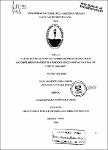| dc.contributor.advisor | Echevarría Chong, Mauro Milko | |
| dc.contributor.author | Pérez Torres, Bella Marjorie | |
| dc.contributor.author | Tapullima Pezo, Liz Sabina | |
| dc.date.accessioned | 2016-09-24T01:44:18Z | |
| dc.date.available | 2016-09-24T01:44:18Z | |
| dc.date.issued | 2010 | |
| dc.identifier.other | T/617.15/P45 | |
| dc.identifier.uri | http://repositorio.unapiquitos.edu.pe/handle/20.500.12737/2934 | es_PE |
| dc.description.abstract | Los traumatismos son una constante en la vida del hombre a través de las generaciones, por lo que son un problema grave de la salud pública tanto a nivel mundial, como en la realidad local. Dentro de los traumatismos en general tenemos las fracturas mandibulares que son tratados dentro de este estudio, que por su elevada prevalencia, merecen que se aborde la problemática que hay tras ellos. Objetivo: Identificar las Características clínicas y Epidemiológicas de fracturas mandibulares en pacientes atendidos en el Hospital Regional de Loreto Felipe Arriola Iglesias (HRL) desde enero del 2006 a diciembre del 2009" Materiales y métodos: Previa autorización de la Dirección del Hospital Regional de Loreto, se procedió a revisar las historias clínicas de los pacientes con el Registro de Egresos de este nosocomio, desde Enero del 2006 a Diciembre del 2009; el estudio fue de tipo cuantitativo, no experimental, de corte transversal, descriptivo, retrospectivo. Resultados: Se obtuvo información de un total de 132 pacientes entre 1 y 60 años; todos presentaron Traumatismos Maxilofaciales; de ellos 40 pacientes tuvieron Fracturas Mandibulares; encontrándose la mayor prevalencia de fractura a nivel del Angulo mandibular 30,0% (n=l2), seguido del cuerpo mandibular 27,5% (n=ll); siendo las de tipo de fractura simple las que más predominaron con un 75,00/o (n=30); el Agente causal de mayor porcentaje son los Accidentes de Tránsito con un 45,00/o (n=IS). Los exámenes radiográficos más usados fuerón las de craneo frontal en un 70,00/o (n=28); teniendo como lesión asociada de mayor porcentaje los TEC 32,5% (n=l3). Discusión: El sitio de fractura más común fue la del Angulo mandibular con 30,0% en segundo lugar el cuerpo mandibular con 27,5%, coincidiendo con otros estudios hechos en otros países, siendo la causa más común los accidentes de tránsito. Conclusión: La fractura más común fue a nivel del ángulo mandibular, siendo la mayor causa los accidentes de tránsito, predominando el sexo masculino entre las edades de 20 a 29 años. Palabras Claves: Fracturas, Mandibulares, traumatismos, maxilofaciales | es_PE |
| dc.description.abstract | Injuries are a constant in human life through the generations, so they are a serious public health both globally and in local realities. Within injuries in general have mandibular fractures are treated in this study, its high prevalence; deserve to be addressing the problems behind them. Objective: To identify clinical and epidemiological characteristics of mandibular fractures in patients attending the Regional Hospital of Loreto Iglesias Felipe Arriola (HRL) from January 2006 to December 2009" Materials and methods: After approval of the Director of the Loreto Regional Hospital, were reviewed medica) records of patients with · discharge records of this hospital, from January 2006 to December 2009, the study was a quantitative non-experimental, cross-sectional, descriptive, retrospective. Results: Information was gathered from a total of 132 patients between 1 and 60, all presented Maxillofacial Trauma, of whom 40 patients had Mandibular fractures, found the highest prevalence of fracture of the mandibular angle at 30.0% (n = 12) followed by the mandibular body 27.5% (n = 11), being the simplest type offracture the most prevalent with 75.0% (n = 30), the causal agent is the highest percentage of traffic accidents with by 45.0% (n = 18). Radiographic examinations used were those of frontal skull in a 70.0% (n = 28), having as associated injury ofTECs highest percentag32.5 %(n=l3). Discussion: The most common fracture site was the mandibular angle with 30.0% in second mandibular body with 27 .5%, coinciding with other studies conducted in other countries, being the most common cause of traffic accidents.
Conclusion: The most common fracture was at the mandibular angle, being the major cause of traffic accidents, mainly boys between the ages of 20 to 29 years. | en_US |
| dc.description.uri | Tesis | es_PE |
| dc.format | application/pdf | en_US |
| dc.language.iso | spa | es_PE |
| dc.publisher | Universidad Nacional de la Amazonía Peruana | es_PE |
| dc.rights | info:eu-repo/semantics/openAccess | en_US |
| dc.source | Universidad Nacional de la Amazonía Peruana | es_PE |
| dc.source | Repositorio Institucional - UNAP | es_PE |
| dc.subject | Fracturas mandibulares | es_PE |
| dc.subject | Diagnóstico clínico | es_PE |
| dc.subject | Factores epidemiológicos | es_PE |
| dc.subject | Terapéutica | es_PE |
| dc.title | Características clínicas y epidemiológicas de fracturas mandibulares en pacientes atendidos en el Hospital Regional de Loreto 2006 - 2009 | es_PE |
| dc.type | info:eu-repo/semantics/bachelorThesis | en_US |
| thesis.degree.discipline | Odontología | es_PE |
| thesis.degree.grantor | Universidad Nacional de la Amazonía Peruana. Facultad de Odontología | es_PE |
| thesis.degree.level | Título Profesional | es_PE |
| thesis.degree.name | Cirujano Dentista | es_PE |
| thesis.degree.program | Regular | es_PE |
| dc.subject.ocde | http://purl.org/pe-repo/ocde/ford#3.02.14 | es_PE |

